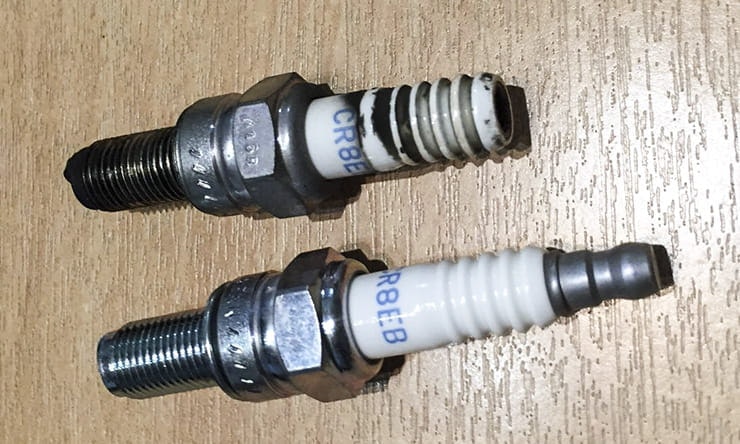KIT CREDITS
Nick Nomikos is the Sales and Service manager of The Two Wheel Centre in Harpenden. An MoT tester since 2002, he’s worked at the family-owned shop since it opened in 1991; “If drawing attention to the importance of basic bike maintenance encourages more people to keep an eye on their bikes, then we’ve won!”
What’s going on here? This Piaggio scooter came in with a misfire – the customer couldn’t understand why their machine wasn’t running properly anymore.
Why does it matter? Unless your motorcycle’s one of the few diesel machines produced, it needs a spark to ignite the fuel vapour. A mixture of air and petrol is sprayed into each of the engine’s cylinders, compressed by the piston, then ignited by the spark plug. No spark means no explosion, which means no going anywhere.
You wouldn’t be able to fashion a temporary spark plug with a cigarette either; contrary to movies and general perceived wisdom, a cigarette doesn’t have enough heat in it to ignite petrol vapour. Heat is a measure of quantity of temperature – while the temperature on a cancer stick is high, there’s not enough of it. Not only can you put a fag out in a puddle of petrol, the far more explosive vapour that sits above it will not ignite either. Don’t try it though – only a fool would mess around with gasoline.
Smoking around fuel is still a bad idea – lighting up will cause ignition. As will a very small spark, such as that from your engine’s plug.
How do we stop this happening to us? If you’re short of money, it can be tempting to extend the time between your service intervals. But manufacturers do give recommended replacement periods for good reason, and while you might think that half of your spark plug is safely tucked away behind a rubber boot, and the other half is nestled inside the engine, it does wear out.
Part of that wear comes from the fact that it can be inside more than 130 explosions every second. Let’s say it takes you half an hour to get to work, and your engine averages 5000rpm. On a four-stroke motor, the plug is likely igniting once every other stroke; so 2500 bangs per minute. That’s 75,000 detonations just to get you to the office. By the time you get home at night, your little spark plug will have endured 150,000 explosions.
How do we fix this? Even during the lifetime of a plug with a very short service interval – like the 8000 miles of Honda’s MSX125 – it’ll probably have been engulfed in a raging ball of flame about 40 million times. But that same plug only costs a fiver.
Keeping on top of your servicing is important – plan for the cost, and stick to it.
Basic motorcycle maintenance is taught in the CBT, but a lot of riders forget about it. If you keep an eye on your bike, you can budget for any upcoming issues. As Nick says: “You should check your motorcycle at least every month (really, before each journey). If you want to ride on a Sunday, check it on the Wednesday – put it on charge, check the tyres, chain, oil, coolant, brake fluid... If you don’t look over it, how can you be sure it hasn’t developed a leak? And keeping your bike clean is a great way to really know it inside out.”
Share on social media:
